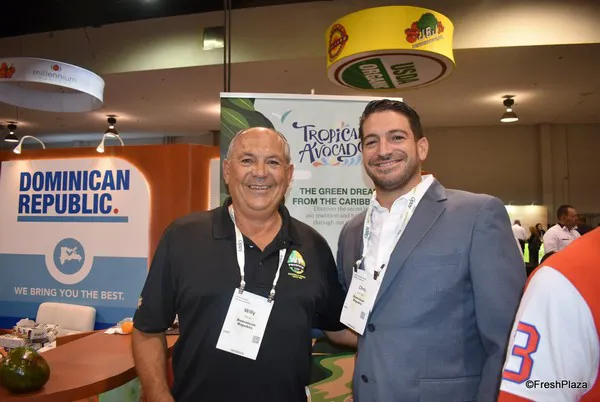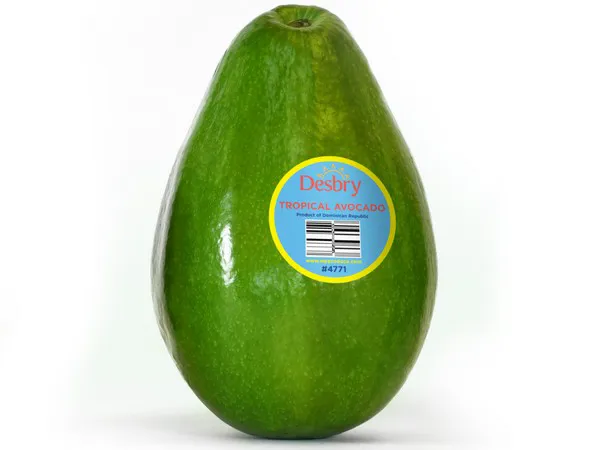Earlier this year, a group of the main players in the green skin avocado market, including WP Produce, worked with Moxxy Marketing and the USDA-funded International Executive Service Corps (IESC) program to gain consumer insights about the fruit. Though already well-known in the Southeast, at the time of the research green skins were a newly emerging product in the rest of the country. While this research identified a strong consumer interest in and demand for these avocados, it also found consumers do not find the name green skin avocados appealing.

Willy Pardo (president) and Chris Gonzales (vice president of sales) of WP Produce.
Chris Gonzalez, Vice President of Sales of WP Produce, shared, “The research was conducted in Houston and San Diego, which are known for being avocado-loving areas with a higher level of consumer demand for the fruit and a desire for variety. After talking to the consumers, we realized we need to re-label this great variety and decided to begin marketing them as Tropical Avocados. So far, the response has been exceptional on both a consumer and a retail level, with positive feedback received from both sides.”
Multiple origins
Tropical Avocados thrive in the lush climates of Florida and the Dominican Republic. The variety has a history of being grown in Florida for quite some time, but recent hurricanes and crop diseases in the region have reduced volumes available from Florida.
“The avocado season for us started in October, and is off to a strong start,” said Gonzalez. “We ship across the U.S., Canada, and Puerto Rico. A majority of our volume comes from the Dominican Republic, which offers year-round availability. We supplement our program with avocados from Florida eight months out of the year, with the high season running from July to October.”

The Tropical Avocados grown in the Dominican Republic come from a mountainous area. “The elevation at which they are grown means the temperatures are a bit cooler than they are in the Florida production areas. This gives the avocados from the Dominican Republic a bit of a different flavor and texture than varieties grown in Florida, while still remaining familiar and recognizable for consumers. Fruit from both growing regions are delicious and hearty; our retail and foodservice partners appreciate the variation and extended seasonality which sourcing from both the Dominican Republic and Florida provides,” Gonzalez says.
This year’s volumes from the Dominican Republic are comparable to other seasons in the past. “We have our own farms, allowing for quality control from grove to delivery, as well as increasing the volume of avocados available to us. We also buy from other farmers we partner with in the area, so our company’s overall volumes are higher than they have been in the past. In general, though, the harvest sizes have been similar to previous years,” he says.
Demand is increasing
The demand for avocados in general has been increasing, and the Tropical variety has not been left behind in this trend. Gonzalez explains, “The main increase in demand can be seen on the West Coast, especially California, with a rise in demand seen in Texas as well. There is a lot of momentum for this product and we only expect it to increase. The Tropical Avocados only have about 5% of the overall avocado market, so there is a lot of room to grow.”
 “We’ve been focusing on informing consumers and retailers about Tropical Avocados, particularly the value they offer, their ideal usage situations, and how to tell when they’re ripe—since they remain a beautiful green color throughout the ripening process,” Gonzalez continues. “The Tropical Avocado has different uses than the Hass—its hearty, smooth texture holds up well in recipes, making it great for salads, smoothies, sandwiches, or even in a few more unorthodox uses such as in soups or ice cream. Tropical Avocados aren’t meant to compete with Hass but rather be in its own category; consumers enjoy the variety and new usage opportunities these avocados provide to the segment, which is further driving demand for the product.”
“We’ve been focusing on informing consumers and retailers about Tropical Avocados, particularly the value they offer, their ideal usage situations, and how to tell when they’re ripe—since they remain a beautiful green color throughout the ripening process,” Gonzalez continues. “The Tropical Avocado has different uses than the Hass—its hearty, smooth texture holds up well in recipes, making it great for salads, smoothies, sandwiches, or even in a few more unorthodox uses such as in soups or ice cream. Tropical Avocados aren’t meant to compete with Hass but rather be in its own category; consumers enjoy the variety and new usage opportunities these avocados provide to the segment, which is further driving demand for the product.”
Right: Chris Gonzalez, Vice President of Sales of WP Produce.
For more information: 
Chris Gonzales
WP Produce
Tel: +1 (305) 326-8333
Email: chris@wpproduce.com
www.wpproduce.com
